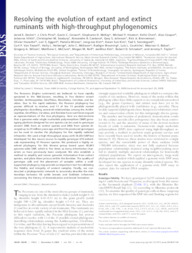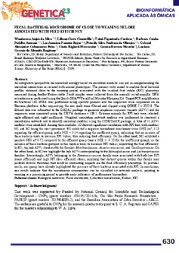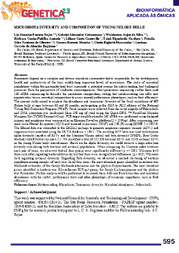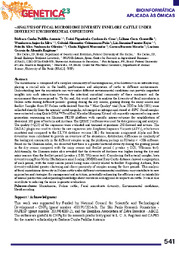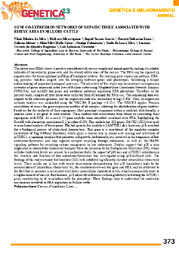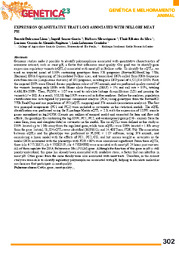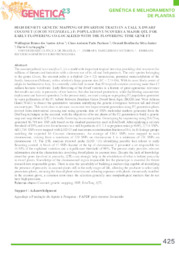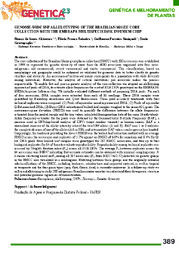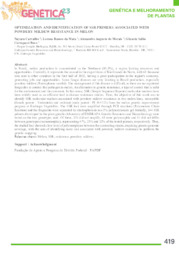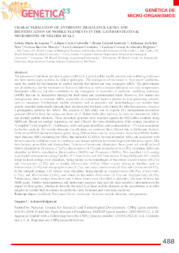Search Publications
Filter by:
| Author(s): DECKER, J. E.; PIRES, J. C.; CONANT, G. C.; MCKAY, S. D.; HEATON, M. P.; CHEN, K.; COOPER, A.; VIKKI, J.; SEABURY, C. M.; CAETANO, A. R.; JOHNSON, G. D.; BRENNEMAN, R. A.; HANOTTE, O.; EGGERT, L. S.; WIENER, P.; KIM, J.-J.; KIM, K. S.; SONSTEGARD, T. S.; TASSELL, C. P. V.; NEIBERGS, H. L.; MCEWAN, J. C.; BRAUNING, R.; COUTINHO, L. L.; BABAR, M. E.; WILSON, G. A.; MCCLURE, M. C.; ROLF, M. M.; KIM, J. W.; SCHNABEL, R. D.; TAYLOR, J. F.
|
| Author(s): SILVA, W. A. da; CONTEVILLE, L. C.; CARDOSO, T. F.; ANTONIO, B. P.; FUENTES ROJAS, L. J.; OLIVEIRA, P. S. N. de; PENÃ, G. A. C.; MARCONDES, C. R.; MOURÃO, G. B.; REGITANO, L. C. de A. An integrative perspective on microbial ecology based on microbial modules can aid in comprehending the microbial interactions associated with animal phenotypes. |
| Author(s): ROJAS, L. J. F.; COLMENAREZ, G. A.; SILVA, W. A. da; ANTONIO, B. C. P.; CONTEVILLE, L. C.; CARDOSO, T. F.; OLIVEIRA, P. S. N. de; MOURÃO, G. B.; MARCONDES, C. R.; REGITANO, L. C. de A. Ruminants depend on a complex and diverse microbial community that is responsible for the development, health and productivity of the host, establishing important levels of association. |
| Author(s): ANTONIO, B. C. P.; CRUZ, T. F. C. da; CONTEVILLE, L. C.; SILVA, W. A. da; PEÑA, G. A. C.; ROJAS, L. J. F.; OLIVEIRA, P. S. N. de; MARCONDES, C. R.; MOURÃO, G. B.; REGITANO, L. C. de A. The microbiome is composed of a complex community of microorganisms, which interact in an intricate way, playing a crucial role in the health, performance and adaptation of cattle to different environ... ... |
| Author(s): SILVA, T. R. da; SILVA-VIGNATO, B.; GARCIA, I. S.; LIMA, B. D.; AFONSO, J.; CESAR, A. S. M.; FUKUMASU, H.; SILVA, S. da L. e S.; REGITANO, L. C. de A.; COUTINHO, L. L. The ribeye area (REA) shows a positive correlation with carcass weight and animal growth, making it a reliable indicator of muscularity, prime cuts, and the overall edible mass of the carcass. |
| Author(s): BEATRIZ, D. L.; GARCIA, I. S.; SILVA-VIGNATO, B.; SILVA, T. R. da; REGITANO, L. C. de A.; COUTINHO, L. L. Genomic studies make it possible to identify polymorphisms associated with quantitative characteristics of economic interest, such as meat pH, a factor that influences meat quality. |
| Author(s): ALVES, W. B. dos S.; PACHECO, C. A. P.; SILVA JUNIOR, O. B. da; GRATTAPAGLIA, D.
|
| Author(s): ALCÂNTARA, B. de S.; TEIXEIRA, F. F.; SIMIQUELI, G. F.; GRATTAPAGLIA, D.
|
| Author(s): CARVALHO, N.; MATA, L. R. da; MORAIS, A. A. DE; BUSO, G. S. C.
|
| Author(s): AQUINO, L. M. DE; CONTEVILLE, L. C.; ANDRADE, B. G.; ZERLOTINI NETO, A.; MOURÃO, G. B.; COUTINHO, L. L.; REGITANO, L. C. de A. The purpose of this study was to explore 916 metagenome-assembled genomes (MAGs) from the rumen and feces of 52 Nelore bulls (Bos indicus), in order to characterize ARGs and identify mobile elements. |
Observation
Some of Embrapa's publications are published as ePub files. To read them, use or download one of the following free software options to your computer or mobile device. Android: Google Play Books; IOS: iBooks; Windows and Linux: Calibre.
Access other publications
Access the Agricultural Research Database (BDPA) to consult Embrapa's full library collection and records.
Visit Embrapa Bookstore to purchase books and other publications sold by Embrapa.

